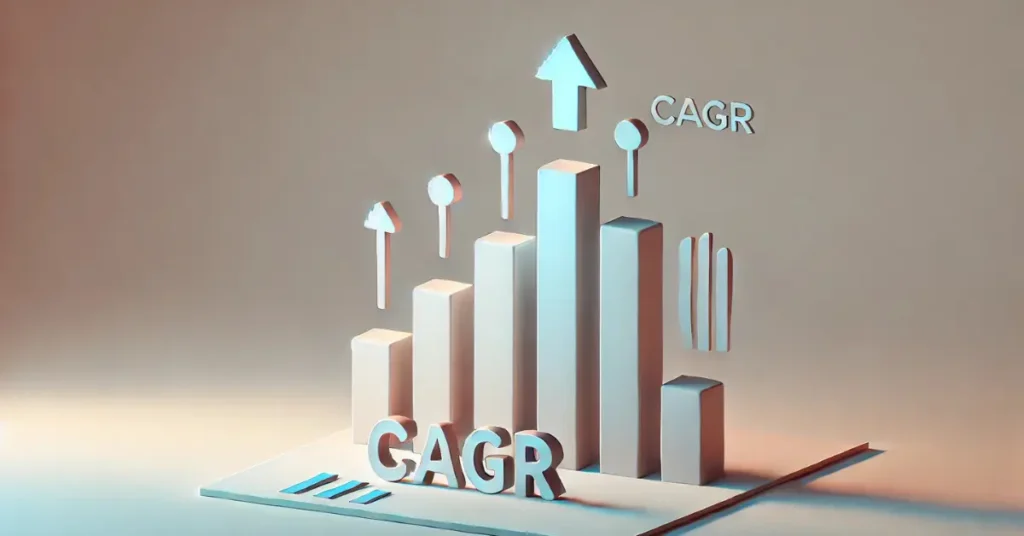Follow Us
CAGR Calculator Online – Calculate Compound Annual Growth Rate

CAGR Calculator
Calculate the Compound Annual Growth Rate of your investments.
What is CAGR (Compound Annual Growth Rate)?
When you first hear the term CAGR - Compound Annual Growth Rate, it might sound a bit complex. But let’s break it down in a simple way.
CAGR is essentially the steady annual growth rate of your investment over time. It tells you the consistent rate at which your investment would need to grow to reach its final value, even if the real year-to-year growth was all over the place.
Think of CAGR as your investment’s "average pace." Whether your portfolio has grown rapidly in one year and stalled in the next, CAGR smooths those bumps out and gives you a clear, single number that represents the overall trend.
One common thing is that people often get confused by fluctuating annual returns. One year you might see a 20% gain, the next year a 10% dip. This is where CAGR becomes valuable. It’s like saying, “Forget the volatility, here’s how your investment grew on average per year.”
It’s used everywhere, from stock market portfolios to real estate and business growth metrics.
Why? Because it’s reliable. CAGR strips away the noise and helps you see what really matters: the consistent growth of your money.
How to calculate CAGR?
Calculating CAGR is simpler than it might seem at first glance.
You don’t need to be a math whiz to understand it; all you need is three key pieces of information: the initial value of your investment (PV), the final value (FV), and the number of years (N) you held that investment.
The formula:
CAGR = [ Final Value (FV) / Initial Value (PV) ] 1/N - 1
Let’s break this down step by step:
- Divide the Final Value by the Initial Value: This shows how much the investment grew overall.
- Raise it to the Power of (1/N): This step adjusts for the number of years you held the investment. Think of it as calculating the annualized growth.
- Subtract 1: This gives you the growth rate, not the final value itself.
Example:
Let’s say you invested $10,000, and after 5 years, it grew to $20,000.
Using the formula:
CAGR = [ 20000 / 10000 ] 1/5 - 1 = 14.87%
So, your investment grew by an average of 14.87% per year over those 5 years. That’s what makes CAGR useful, it gives you the average annual growth, no matter how volatile the market was in between.
When to Use the CAGR Calculator?
A CAGR calculator can come in handy in several scenarios, particularly when you want to understand the real growth of your investments or business metrics over time. But when exactly should you use it?
1. For Long-Term Investments
If you’ve held an investment for several years and the annual returns have been volatile, the CAGR calculator helps smooth out those fluctuations.
Let’s say one year your investment grows by 15%, but the next year it drops by 5%. CAGR gives you the average annual growth over time, which is often more meaningful than looking at individual yearly changes.
2. Comparing Multiple Investments
When you have several investments or portfolios with varying returns, the CAGR calculator lets you compare them on a level playing field.
3. Evaluating Business Growth
CAGR isn’t just for personal investments - it’s also widely used by businesses. For example, you can use it to track revenue growth or customer base expansion over several years. It helps cut through the noise of year-to-year changes and gives a clearer picture of overall growth.
4. Financial Planning and Forecasting
If you’re looking to forecast future returns or project the value of an investment, the CAGR calculator can help. It’s a reliable way to estimate how much an investment might grow over time, given a consistent growth rate. This is particularly useful when planning for retirement or major financial goals.
Simply put, whenever you need to measure long-term growth or compare different investments, the CAGR calculator is a tool you can rely on.
Limitations of CAGR
While CAGR is a great tool for measuring growth, it’s not without its limitations.
1. Ignores Volatility
One of the biggest issues with CAGR is that it smooths out returns and doesn’t account for the ups and downs your investment might have faced.
For instance, if you had a 20% gain one year and a 10% loss the next, CAGR won’t reflect that rollercoaster. It gives you the average growth but ignores the volatility, which is crucial for understanding risk.
2. Doesn’t Show Interim Performance
CAGR only looks at the starting and ending points, leaving out everything that happened in between. This can be misleading if an investment performed poorly for several years before bouncing back.
It hides the fact that your portfolio might have been underwater for a while, which can matter when you’re deciding whether to stick with or exit an investment.
3. Assumes Constant Growth
In the real world, investments rarely grow at a constant rate, yet CAGR gives you the impression that growth was smooth over the period.
This can be misleading if you’re trying to assess how an investment might perform in the future. It assumes past growth patterns will continue, which we know isn’t always the case.
4. Not Ideal for Short-Term Analysis
I wouldn’t recommend using CAGR for short-term investments. Since it’s designed to show long-term growth, it doesn’t capture the nuances of shorter time frames.
For short-term investments, other metrics like simple growth rate or annual return might give you a more accurate picture of performance.
5. Doesn’t Factor in External Factors
CAGR doesn’t take into account any fees, taxes, or inflation that could eat into your returns. So while it might show a great growth rate, you still need to consider the impact of these external factors on your actual earnings. For more detailed analysis, pairing CAGR with metrics like net present value (NPV) can help.
In summary, while CAGR is useful, it’s not the full story. You should always complement it with other metrics, especially when analyzing volatile or short-term investments. It’s a great starting point, but don’t stop there.
Steps to Use the CAGR Calculator
Using a CAGR calculator is quick and straightforward.
1. Enter the Initial Value
This is your starting investment amount. For example, if you initially invested $10,000, that’s your starting point. The calculator needs this value to understand where your investment began.
2. Enter the Final Value
Next, input the final value of your investment. This is how much your investment is worth at the end of the time period you’re calculating. For instance, if your investment grew to $15,000, that’s your final value.
3. Enter the Duration of Investment
Now, specify the time period over which your investment grew. This is usually in years. So, if you held onto your investment for 5 years, you’d enter “5” in this field.
4. Hit Calculate
After you’ve entered these three pieces of information, hit the “Calculate” button. The calculator will quickly crunch the numbers and give you your CAGR, showing how much your investment grew annually on average.
5. Review the Results
Once you hit calculate, the CAGR result will appear, usually in percentage form. This is the annualized rate of growth that represents your investment's performance over the selected time period. It’s a single number that summarizes years of performance.
These simple steps make the CAGR calculator a powerful tool for evaluating long-term growth, and you don’t need to be a math expert to use it. It saves time and provides a clearer view of your investment’s real performance.
Related Metrics to Consider
While CAGR gives you a clear view of your investment's growth, it’s not the only metric you should rely on. Over the years, I’ve learned that getting the complete picture requires looking at a many more additional metrics. Here are some related metrics to consider:
1. Standard Deviation
CAGR is great for showing average growth, but it doesn’t account for volatility. That’s where standard deviation comes in. It measures how much your investment’s returns fluctuate from the average.
If you have two investments with similar CAGRs, the one with a higher standard deviation is riskier because it has bigger swings in returns. So, while CAGR tells you what your growth looks like, standard deviation tells you how stable that growth is.
2. Sharpe Ratio
Investors often overlook the Sharpe ratio, but it’s an important one, especially when you’re weighing risk against reward. It calculates how much extra return you’re getting for each unit of risk.
If two investments have the same CAGR but one has a higher Sharpe ratio, that’s the one offering better risk-adjusted returns. I always recommend using the Sharpe ratio alongside CAGR when comparing investment options.
3. Internal Rate of Return (IRR)
While CAGR focuses on growth over a specific period, IRR takes things a step further by considering the timing of cash flows. It’s particularly useful for real estate or business investments where money goes in and out over time.
IRR calculates the overall profitability of an investment by factoring in the value and timing of each inflow and outflow. If you’re managing multiple investments with varying cash flows, IRR is the metric you’ll want to rely on.
4. Net Present Value (NPV)
When making investment decisions, it’s not just about growth but also the value of future returns in today's terms. NPV helps you assess whether an investment is worth pursuing by calculating the difference between the present value of future cash inflows and the initial investment.
It’s a powerful tool for evaluating long-term projects or comparing different investments when future cash flows are involved. NPV gives you a clearer picture of the actual profitability, especially in projects with multiple cash flows.
5. Return on Investment (ROI)
If you’re looking for a simpler metric, ROI is a straightforward way to measure your investment’s performance. It calculates the percentage return by comparing the initial investment to the gain or loss.
While ROI is easy to use, it doesn’t account for time, so it’s not as precise as CAGR for long-term investments. But when you just want a quick snapshot of how well an investment has done, ROI can be helpful.
Using CAGR alone can give you a good sense of average growth, but it’s not the full story. Metrics like standard deviation, Sharpe ratio, IRR, NPV, and ROI help you dig deeper into your investment's risk, cash flow, and actual profitability. Pairing these metrics with CAGR will give you a more rounded view and help you make smarter financial decisions.
Explore our other Calculators
FAQ's related to CAGR
What is a good CAGR percentage?
A good CAGR depends on the type of investment. For equity funds, a CAGR of 12% or more is generally considered solid, while for debt funds, 8% is reasonable. The ideal rate varies based on risk appetite and market conditions.
Why is CAGR better than a simple average?
CAGR is better than a simple average because it accounts for the compounding effect, showing more accurate growth over time. Simple averages can mislead by ignoring fluctuations and compounding.
Can CAGR be negative?
Yes, CAGR can be negative if the final value of an investment is lower than the initial value, indicating a loss over the period.
What is the difference between XIRR and CAGR?
XIRR accounts for irregular cash flows, making it more flexible than CAGR, which assumes consistent investments. XIRR is used when money is added or withdrawn at different times.
Is CAGR the same as annual return?
No, CAGR smooths out annual returns to show a steady growth rate over time, while annual return reflects the actual gains or losses each year, which can vary significantly.
Disclaimer:
This content is for informational purposes only and should not be considered financial advice.
Read full Disclaimer.


